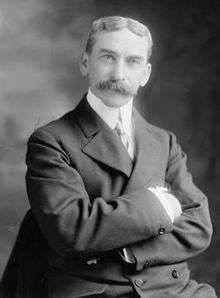Henry Lane Wilson
| Henry Lane Wilson | |
|---|---|
 | |
| United States Ambassador to Mexico | |
|
In office December 21, 1909 – July 17, 1913 | |
| President | William Howard Taft |
| Succeeded by | John Lind |
| Personal details | |
| Born |
November 3, 1857 Crawfordsville, Indiana |
| Died |
December 22, 1932 (aged 75) Indianapolis, Indiana |
| Resting place | Crown Hill Cemetery, Indianapolis |
| Spouse(s) | Alice Vajen |
| Parents | James and Emma Ingersoll Wilson |
| Alma mater | Wabash College |
| Profession | Attorney |
Henry Lane Wilson (November 3, 1857 – December 22, 1932) was an American attorney who was appointed to the post of United States Ambassador to Mexico in 1910.
Biography
| A graphical timeline is available at Timeline of the Mexican Revolution |
He was born in Crawfordsville, Indiana, to Congressman James Wilson and his wife, Emma Ingersoll. In 1866, his father was appointed to the position of Minister Resident to Venezuela by President Andrew Johnson and served in that role until his death in Caracas, Venezuela, on August 8, 1867. Henry Lane Wilson was a law graduate of Wabash College and practiced law and published a newspaper in Lafayette, Indiana. He married Alice Vajen in 1885,[1] and moved to Spokane, Washington, where he was in business until he was wiped out financially in the Panic of 1893.[2]
Diplomatic Service
Wilson served in the US Foreign Service during the presidencies of William McKinley (1897–1901), Theodore Roosevelt (1901–1909) and William Howard Taft (1909–1913). He was appointed Minister to Chile in 1897, remaining in that capacity until 1904, when he was made Minister to Belgium, serving in Brussels during the height of the Congo Free State controversy. Wilson was appointed ambassador to Mexico in 1910, where he instrumented the fall of the first democratic Mexican government of Francisco I. Madero, and was a key actor in bringing to power military dictator Victoriano Huerta, prolonging the Mexican Revolution.[3]
Ambassador to Mexico
Wilson was appointed Ambassador to Mexico by President Taft on December 21, 1909 and presented his credentials to President Diaz on March 5, 1910.[4] Wilson was ordered by William Howard Taft to remain neutral and to not make the USA responsible for the outcome of the occurring rebellions in Mexico at the time.[5] He became personally acquainted with some of the most important figures of the Revolution, such as Álvaro Obregón, Venustiano Carranza, Pancho Villa, and Francisco I. Madero. As Taft's Ambassador to Mexico, fearing the leftist tendencies of the new Madero government upon the ouster of Diaz (not to mention the fact that he considered Madero a 'lunatic'),[4] he assumed the role of catalyst for the plot of General Victoriano Huerta, Felix Díaz, and General Bernardo Reyes against President Madero,[6] and was purported to have assisted in arranging the murder of Madero and his vice-president, José María Pino Suárez, during La decena trágica (The Ten Tragic Days) in February 1913, a point that was later disputed by Wilson.[3][7] After his inauguration in March of that year, President Woodrow Wilson was informed of events in Mexico by a special agent, William Bayard Hale, and was appalled by Henry Lane Wilson's assistance to the Huerta coup d'état against Madero.[8] Hale reported that "Madero would never have been assassinated had the American Ambassador made it thoroughly understood that the plot must stop short of murder", and accused the ambassador of "treason, perfidy and assassination in an assault on constitutional government".[9] The President supplanted him by sending as his personal envoy John Lind, the former governor of Minnesota, and on 17 July 1913,[4] the President dismissed Ambassador Wilson.[10]
Post-government activities
During the First World War, Wilson served on the Commission for Relief in Belgium and, in 1915, accepted the chairmanship of the Indiana State Chapter of the League to Enforce Peace, a position he held until his resignation over US involvement in the League of Nations after the close of the war. Wilson was a member of Sons of the American Revolution, Society of Colonial Wars and the Loyal Legion.[1] He published his memoir in 1927, and died in Indianapolis in 1932. He is buried in Crown Hill Cemetery, Indianapolis.
References
- 1 2 Archived September 25, 2009, at the Wayback Machine.
- ↑ "Inventory of the Henry Lane Wilson Papers, 1910-40". Oac.cdlib.org. Retrieved December 7, 2014.
- 1 2 McLynn, Frank (2002). Villa and Zapata. Carroll & Graf. ISBN 0-7867-1088-8.
- 1 2 3 "HENRY LANE WILSON : 1857 - 1932 : Conservative Republican Ambassador plots against Mexican President". Emersonkent.com. Retrieved December 7, 2014.
- ↑ Howard Francis Cline, The United States and Mexico (Harvard University Press, 1965), p. 130
- ↑ "Henry Lane Wilson - The Mex Files". Mexfiles.net. Retrieved 7 December 2014.
- ↑ "Henry Lane Wilson Sues. Asks $350,000 from Norman Hapgood for Alleged Libel" (PDF). New York Times. 11 May 1916. Retrieved December 7, 2014.
- ↑ "Yahoo". Yahoo. Archived from the original on September 24, 2012. Retrieved December 7, 2014.
- ↑ Schoultz, Lars (1998). Beneath the United States: a history of U.S. policy toward Latin America ([Fourth printing]. ed.). Cambridge, MA: Harvard University: Harvard University Press. p. 240. ISBN 0-674-92276-X.
- ↑ "All the Brains I Can Borrow: Woodrow Wilson and Intelligence Gathering in Mexico, 1913–15". Central Intelligence Agency. Retrieved August 22, 2009.
External links
| Wikimedia Commons has media related to Henry Lane Wilson. |
| Diplomatic posts | ||
|---|---|---|
| Preceded by Lawrence Townsend |
Ambassador to Belgium 1905–1909 |
Succeeded by Charles Page Bryan |
| Preceded by David Eugene Thompson |
Ambassador to Mexico 1909–1913 |
Succeeded by Henry P. Fletcher |